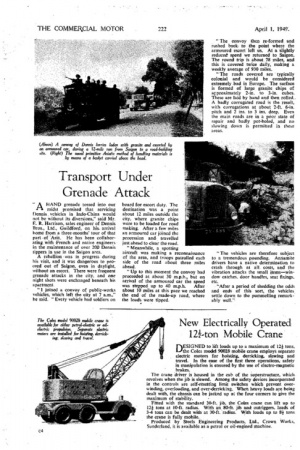Transport Under Grenade Attack
Page 12

If you've noticed an error in this article please click here to report it so we can fix it.
A HAND grenade tossed into our midst promised that servicing Dennis, vehicles in Indo-China would not be without its diversions," said Mr. E. R. Harrison, sales engineer of Dennis Rros., Ltd., Guildford, on his.. arrival home from a three-months' tour of that part -of -Asia. He has been collaborating with French and native engineers in the maintenance of over 200 Dennis tippers in use in the Saigon area
A rebellion was in progress during his visit, and it was dangerous to proceed out of Saigon, even in daylight, without an escort. There were frequent grenade attacks in the city, and one night shots were exchanged beneath his apartment "I joined a convoy of public-works vehicles, which left the city at 7 a.m.," he said. " Every vehicle had soldiers on board for escort duty. The destination was a point about 12 miles outside the city, where granite chips were to be loaded for road making. After a few miles an armoured car joined the procession and travelled just ahead to clear the road.
"Meanwhile, a spotting aircraft was making a reconnaissance of the area, and troops patrolled each side of the road about three miles ahead.
"Up to this moment the convoy had proceeded at about 30 m.p.h., but on arrival of the armoured car the speed
was stepped up to 40 m.p.h. After about 10 miles at this pace we reached the end of the made-up road, where the loads were tipped. "The convoy then re-formed and rushed backto the point where the armoured escort left us. At a slightly reduced speed we returned to Saigon. The round trip is about 78 miles, and this is covered twice daily, making a weekly average of 930 miles.
"The roads covered are typically colonial and would be considered extremely bad in Europe. The surface is formed of large granite chips of approximately 2-in, to 3-in, cubes. These are laid by hand and then rolled.. A badly corrugated road is the result, with corrugations at about 2-ft. 6-in. pitch and 2 ins. to 3 ins. deep. Even the main roads are in a poor state of repair and badly pot-holed, and no slowing down is permitted in these areas.
"The vehicles are therefore subject to a tremendous pounding. Annarnite drivers have a native determination to crash through at all costs, and the vibration attacks the small items—window catches, door handles, seat fixings, etc.
"After a period of shedding the odds and ends of this sort, the vehicles settle down to the pummelling remarkably well."


























